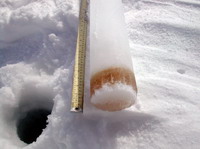Arctic habitats: Difference between revisions
| Line 32: | Line 32: | ||
Filamentous photosynthetic algae is the main microbe that you will find in floating sea ice. These algae are very important to the local ecosystem of the arctic and provide 57 percent of the marine primary production that occurs(Krembs and Deming 2011). The algae usually inhabits the lower areas of the ice and my make chains that extend out into the sea water itself to obtain nutrients. | Filamentous photosynthetic algae is the main microbe that you will find in floating sea ice. These algae are very important to the local ecosystem of the arctic and provide 57 percent of the marine primary production that occurs(Krembs and Deming 2011). The algae usually inhabits the lower areas of the ice and my make chains that extend out into the sea water itself to obtain nutrients. | ||
=In permafrost soils= | |||
Many nitrogen fixing bacteria exist in permafrost soils due to the lack of nutrients that are available to them. Mycorrhizal fungi are also prevalent and form a symbiosis with many arctic plants allowing them the ability to obtain nitrogen in the poor soil. If you want to read more on permafrost soil microbes a more detailed explanation can be found on the [alaskan tundra] page. | Many nitrogen fixing bacteria exist in permafrost soils due to the lack of nutrients that are available to them. Mycorrhizal fungi are also prevalent and form a symbiosis with many arctic plants allowing them the ability to obtain nitrogen in the poor soil. If you want to read more on permafrost soil microbes a more detailed explanation can be found on the [alaskan tundra] page. | ||
Revision as of 10:34, 6 April 2011
Introduction
The Arctic is any space that is within the arctic circle that lies around the 66 degree latitude line. The arctic region is mostly made up of water and floating ice and what land that is contained within the arctic circle is made up of coastlines and small islands. The average temperature is very low with very little rainfall per year and do to its position on earth the arctic circle can experience weeks without the sun rising or vise versa weeks where the sun never sets. Such strange conditions limits what organisms can survive in the arctic. Since all of the circle is above the tree line only small shrubs, mosses and lichens grow and larger fuana include artic hares, foxes and musk oxen. Within this environment many habitats exist that are home to varieties microbes. Sea ice, permafrost soils, and thaw ponds on the thick ice shelves are the three main habitats for microbial life in the arctic (Vincent et al. 2009). In the floating sea ice, algae thrive in the pore spaces in the ice and make up an essential part of the primary producers for the micro ecosystem contained on the sea ice. On land decomposers and nitrogen fixaters dominate the environment and allows what little vegetation that is there to survive.
Physical and Chemical environment
Temperature
The average temperature in the Arctic circle region in winter is -40 degrees F and temperatures as low as -90 degrees F have been recorded(Kenneth 2002).
Sea Ice
Microbes living inside the pore spaces of sea ice are greatly effected by temperature since pore space increase/decreases based on the temperature which can limit the photosynthetic activity of the inhabiting algae(Krembs and Deming 2011).
Nutrient Deficiencies
permafrost soils do not allow for nutrients to be able to be easily accessible do to the frost layer and since the temperature is below freezing for most the year decomposition rates are slowed down making nutrients obtained from decomposition to cycle slower(Ostroumov and Siegert 1996).
Microbial communities
What kind of microbes do we typically find in this environment? Or associated with important processes in this environment? Describe key groups of microbes that we find in this environment, and any special adaptations they may have evolved to survive in this environment. List examples of specific microbes that represent key groups or are associated with important processes found in this environment. Link to other MicrobeWiki pages where possible.
Are there important biological interactions that are important in this environment? Do these interactions influence microbial populations and their activities? How do these interactions influence other organisms? Describe biological interactions that might take place in this environment, using as many sections/subsections as you require. Look at other topics available in MicrobeWiki. Create links where relevant.
In Sea Ice
Filamentous photosynthetic algae is the main microbe that you will find in floating sea ice. These algae are very important to the local ecosystem of the arctic and provide 57 percent of the marine primary production that occurs(Krembs and Deming 2011). The algae usually inhabits the lower areas of the ice and my make chains that extend out into the sea water itself to obtain nutrients.
In permafrost soils
Many nitrogen fixing bacteria exist in permafrost soils due to the lack of nutrients that are available to them. Mycorrhizal fungi are also prevalent and form a symbiosis with many arctic plants allowing them the ability to obtain nitrogen in the poor soil. If you want to read more on permafrost soil microbes a more detailed explanation can be found on the [alaskan tundra] page.
Microbial processes
What microbial processes define this environment? Describe microbial processes that are important in this habitat, adding sections/subsections as needed. Look at other topics in MicrobeWiki. Are some of these processes already described? Create links where relevant.
Subsection 1
Subsection 1a
Subsection 1b
Subsection 2
Current Research
Enter summaries of recent research here--at least three required
References
Edited by <your name>, a student of Angela Kent at the University of Illinois at Urbana-Champaign.


